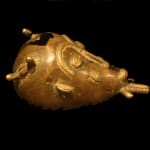Baule Miniature Bronze Mask, 20th Century CE
Bronze
2.75 x 1.25
SP.214
Further images
Some of the finest metal castings from the Ivory Coast are in the form of human heads, or more specifically, human faces. Although they are commonly referred to as “mask,”...
Some of the finest metal castings from the Ivory Coast are in the form of human heads, or more specifically, human faces. Although they are commonly referred to as “mask,” they have no known association with masking traditions or cults. These faces generally depict males with beards and small moustaches, although they could represent anyone, whether male or female, beautiful or ugly. The Baule call these works, ngblo or stan trå, meaning, “a human head.” Both men and women traditionally wear them as hair ornaments or as necklaces. Occasionally, they are still publicly displayed during special festivals as signs of wealth and beauty. There was no particular restriction regarding the ownership of such ornaments. These works were not the private regalia of the king and his loyal followers, for they could be owned by anyone who could afford one. Such heads are said to represent “portraits” or friends and lovers. Others are told to depict deceased ancestors or former kings. The facial features are highly abstracted. The eyes look like two coffee beans. Ears and eyebrows are represented, as are pairs of keloid scars on the cheeks and forehead. These decorative scarifications served both as marks of prestige and beauty. Nodules of tightly braided hair protrude from the top, suggesting a full head of braids. The longer we gaze at this mask, the cultural significance of the piece becomes increasingly obvious, and we stare not at a work of art, but a representation of our lost friends and lovers memorialized in this little treasure of African art.





